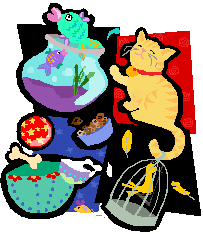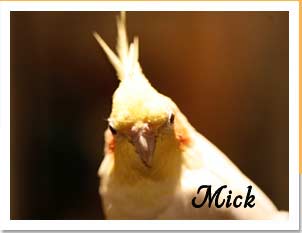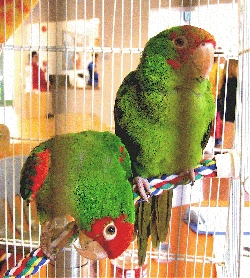Can Furred and Feathered Live Together?
By Robin Fritz
 "The dogs actually love the birds. At dinnertime, the birds feed them." This is Mickaboo volunteer and foster dad Scott Shipley's response, when asked whether it's possible to have canine or feline family members in the same home with avian ones. And no, he wasn't referring to the birds becoming the dogs' dinner!
"The dogs actually love the birds. At dinnertime, the birds feed them." This is Mickaboo volunteer and foster dad Scott Shipley's response, when asked whether it's possible to have canine or feline family members in the same home with avian ones. And no, he wasn't referring to the birds becoming the dogs' dinner!
It seems to be widely believed that if you're going to have birds, you can't have natural predators, like cats and dogs, in your home as well; at least, not safely. However, many people are making this type of mixed animal family work, and under supervision and in the right circumstances, their animal companions can even enjoy some interaction with each other. Scott later elaborated, "My U2 [umbrella cockatoo], Gracie, loves to feed the dogs at dinner time. Once she gets her fill, she starts tossing the remaining food to the dogs. ... If for some reason one of the dogs isn't right there (which rarely ever happens), she has her own special call to get their attention."
It appears, logically enough, that the feather/fur combination is easiest to maintain when you have larger--or at least medium-sized--birds. Priya Tuvell‘s home is the residence of six dogs, all under 12 pounds, and four cats, in addition to her four birds, which include a Congo African Grey and a Senegal parrot. One of her strategies was to "have my Senegal bite everyone; just a paw or something while we were restraining the furry four-legged one very well. It didn't cause damage, but made everyone scared of the loud things with the beaks when they are out of their cages." In fact, Priya has to protect one small, older Yorkshire terrier from being terrorized by the African Grey parrot! Scott, too, has "big birds and three small dogs, so the dogs don't mess with the birds." He adds that his cat "stays far away when the birds are out."
Shelley Buttler is proudly owned by three dogs, one cat, and two chinchillas, in addition to her eight medium-to-large birds, including foster birds. (Yes, eight.) She says the only source of discord amongst the animals is that the cat has a strong dislike for sharing a litter-box with any other cats (which she also sometimes fosters). Most of her birds are large species, such as macaws and amazons, but she shared a sweet feathers-and-fur tale about a smaller bird: "I had a lop-eared bunny once, who managed to get her fat butt into a parakeet cage. When I tried to get her out, my parakeet attacked me. He loved rubbing and preening Echo. I had to dismantle the cage to get Echo out. My parakeet wanted to keep her! And she was happily eating his bird seed." Of course, rabbits are not known for their carnivorous tendencies. With the size difference between a budgie and the average bunny, however, accidents could happen, which is why Shelley needed to separate Echo from her avian friend and evict her from the bird cage.
One key to a happy multi-species family is careful supervision, combined with knowledge of your fluffy friends' personalities. Jill Shepard's cat, Bubba, has been photographed lounging next to Lucky, the rescued racer pigeon, on the top bunk of Jill's son's bunk-bed. She describes their first meeting thus: "Lucky was in her cage, and we saw Bubba come into the room. Rather than assume that she would want go after Lucky, we watched and stayed within a safe distance to grab her if need be. She walked up to Lucky's cage, sniffed her with indifference (the way only cats can do) and plopped over with her back to Lucky's cage. It was a nice first step for both Bubba and Lucky." Jill goes on to explain that Lucky's husband Lenny and another pigeon named Luna also make their homes with her, and she fosters other pigeons as well, often "within sight/smell of dogs and cats. I monitor carefully to make sure everybody gets along."
Some people simply ensure that the birds are always separated from the other non-human household members. Some have a room just for their birds, and can keep the door closed when potential hunters are prowling nearby. Other methods include using portable toddler fences, as Scott does: "I use [a short fence] to keep the dogs away from the cages. But I do this to keep them from rummaging under the cages and strewing paper and poop all over." On the other hand, some households appreciate the furry members' willingness to help with the housekeeping by cleaning up food dropped (or tossed) from parrot cages.
Each family is different, and has worked out different ways of ensuring that all of their loved ones--whether two-legged, four-legged, or winged--are safe and can get along with the others. It is truly surprising the way so many creatures can form bonds with each other across the chasm of vastly differing physical characteristics and instincts. Or is it, really? We humans do this every moment, without thinking twice.

